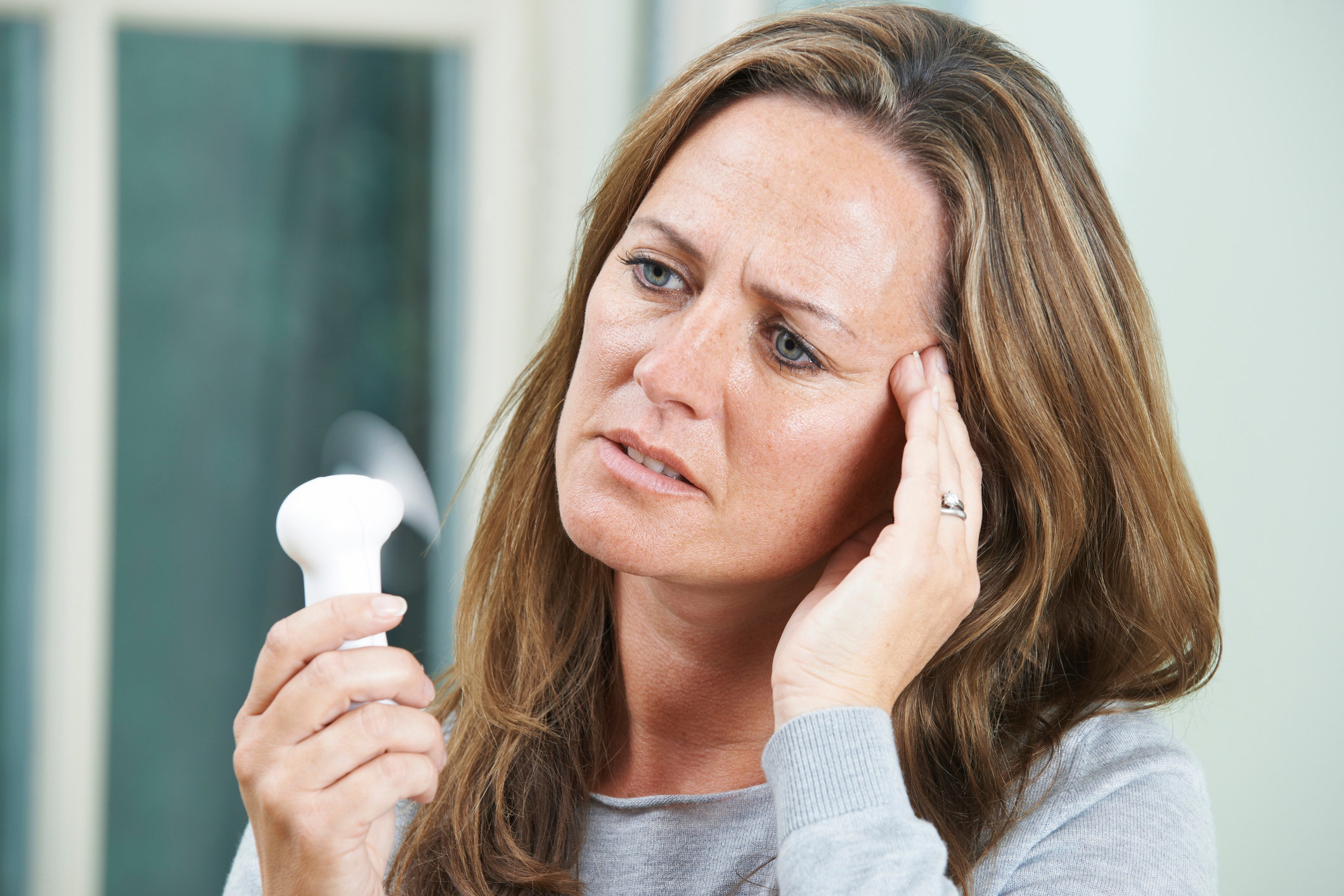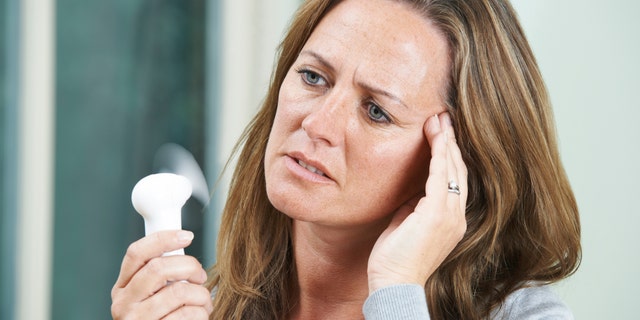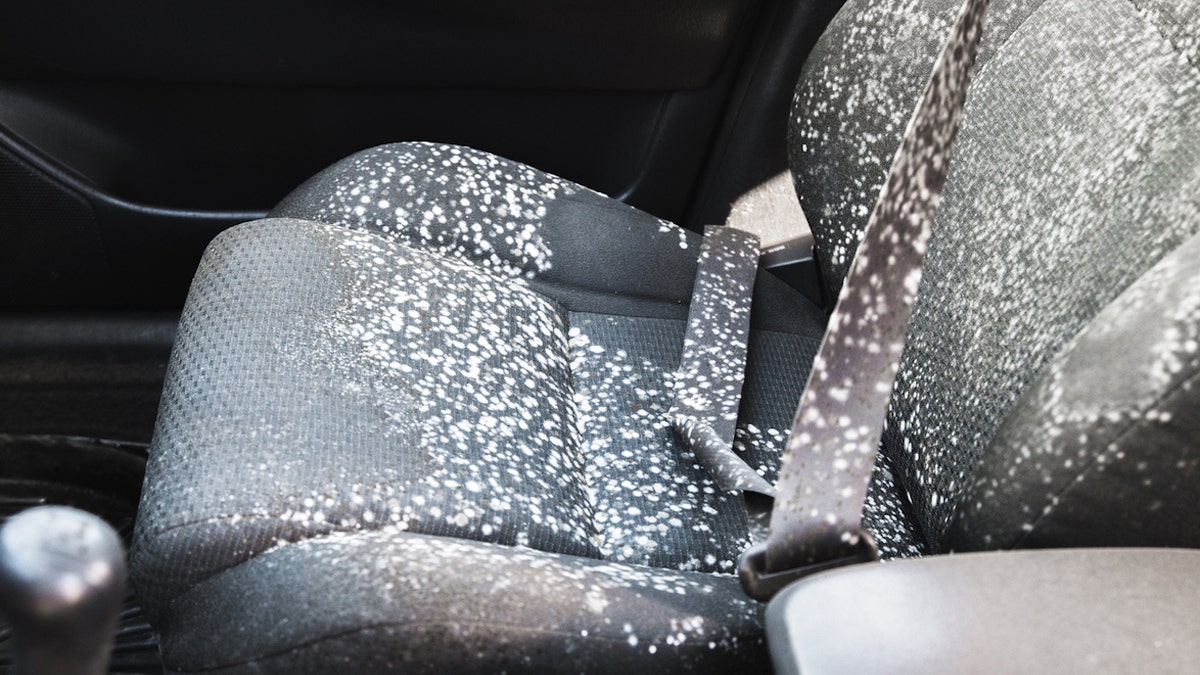Health
5 natural, non-hormonal solutions for menopause symptoms

Between those dreaded hot flashes, night sweats, mood swings and hours spent tossing and turning at night, menopause can be downright miserable.
Hormone replacement therapy is one option, but if you’re concerned about the risks or want to try natural fixes first, the good news is that there are non-hormonal remedies that can help.
A woman officially enters menopause when 12 consecutive months have passed without a menstrual period.
Leading up to this time, periods can be irregular. This often happens between the ages of 45 and 55.
6 WAYS YOU’RE MAKING YOUR MENOPAUSE SYMPTOMS WORSE
There are lots of symptoms that come with menopause that can be frustrating and affect your day-to-day life.
Here are five of the most common symptoms of menopause and natural remedies to try to relieve each symptom.
Women go through menopause after they haven’t had a period for 12 months in a row. (Fabian Sommer/picture alliance via Getty Images)
- Hot flashes
- Night sweats
- Vaginal dryness
- Insomnia
- Irritability
- Bladder control
- Dry skin
1. Hot flashes
It’s unclear what causes hot flashes, but they might be linked to the adrenal glands. When estrogen falls during menopause, the adrenal glands can become deficient, which then causes a surge of cortisol to be released and, in turn, hot flashes, said Dr. Prudence Hall, founder of The Hall Center in Santa Monica, California.
Approximately 80% of women will experience hot flashes and about 10% will have significant hot flashes that last for over 10 years, said Dr. Mary Jane Minkin, a clinical professor of obstetrics, gynecology and reproductive sciences at Yale University School of Medicine in New Haven, Connecticut, and author of “A Woman’s Guide to Sexual Health.”
Herbs such as black cohosh, wild yam, Korean ginseng and red clover can help, but you should consult with a physician, naturopath or herbalist to make sure you choose a reputable brand.
Also, avoid triggers like wine and spicy foods; try adding soy foods to your diet and dress in layers.

Hot flashes are one of the most common systems of menopause. (iStock)
Although exercise will likely make your hot flashes worse while you’re doing it, it can help alleviate symptoms throughout the day.
NAOMI WATTS ADMITS SHE WAS ‘SPIRALING OUT OF CONTROL’ WHEN SHE WENT THROUGH MENOPAUSE AT 36 YEARS OLD
Women who reported less than three sessions a week of physical activity had more severe symptoms of menopause, including hot flashes, compared to women who were more active, a study in the journal Menopause found.
Losing weight can also help hot flashes, since women who are heavy have worse hot flashes than slimmer women, Minkin said.
2. Night sweats
Approximately 95% of women will also deal with night sweats, which is not only uncomfortable, but it makes getting a good night’s sleep nearly impossible.
To feel better, adjust the thermostat, try cooling sheets, pillows or blankets and wear moisture-wicking pajamas.
ACTRESS CHERYL HINES ON THE AWKWARDNESS OF MENOPAUSE
You can also open up your windows if it is not too hot or too cold — and put a fan close to your bedside.

Night sweats can be extremely uncomfortable, so making sure you have a cool environment is essential. (iStock)
3. Vaginal dryness
Unlike hot flashes that tend to get better with time, unfortunately vaginal dryness gets worse. The decrease in estrogen levels causes the vaginal tissues to become thin and dry, which leads to discomfort, itching, irritation and pain during sexual intimacy.
If it’s not treated, vaginal dryness can lead to atrophic vaginitis, a condition that causes the walls of the vagina to become inflamed.
Some things to try to include long-lasting over-the-counter moisturizers that can be used two to three times a week, or coconut oil and personal lubricants when you have sex.
4. Insomnia
Restlessness, waking up several times throughout the night, or trouble falling asleep are all common during menopause.
Questioning who you are or your life’s purpose, which is common during this stage of life, can cause anxiety and also make sleeping difficult, Hall said.

Menopause can cause individuals to have a hard time falling asleep and staying asleep at night. (iStock)
Make a point to exercise every day, which can help you sleep — but if you do it too close to bedtime, it might keep you up.
Avoid known triggers like alcohol and caffeine, and practice good sleep hygiene by keeping your bedroom cool and dark and powering down electronics one to two hours before you get into bed.
Acupuncture can help relieve sleep disturbances associated with menopause too, according to a systematic review and meta-analysis published in the journal Obstetrics & Gynecology.
You can also try calming practices like yoga and meditation before hitting the hay to keep yourself extra relaxed.
5. Irritability
During menopause, there are many factors at play that can cause you to feel on edge.

During menopause, continue to do the things that you love to do, keep yourself busy and practice calming techniques when necessary. (iStock)
For starters, when estrogen is low, it can affect the neurotransmitters in the brain and lead to irritability and mood swings. If your libido is low and your body isn’t releasing oxytocin, the “love hormone” during an orgasm, your mood can suffer. Not to mention that if you’re not sleeping, you’re bound to feel crabby.
To cope, find opportunities to de-stress and relax, whether it’s heading to the spa for a massage, meditating or meeting friends for dinner. If your poor mood persists, it’s important to see your doctor because thyroid levels can plummet during menopause, which might be the real reason you’re feeling low.
Remember to continue doing the things that bring you joy.
Although menopause is no walk in the park, it’s important to take time to take care of yourself.
“Even if we’ve given our care, our love and our attention to everyone else, now is the time for ourselves, so we stay full of light, love and life,” Hall said.
6. Bladder control
It is common to lose bladder control during menopause.
Some things you can do to help with bladder control during menopause is to lower your intake of beverages that contain caffeine, since this typically fills the bladder quickly.
You can also try a more scheduled approach to going to the bathroom. While this may take time to establish, try to retrain your body to go to the bathroom at certain times of the day, which over time can help the urge to use the bathroom at any point in the day go away.
Two times of the day to plan a trip to the bathroom are as soon as you wake up in the morning and before going to bed for the night. Also, try to not drink too much water right before you go to bed to avoid having to go during the night.
7. Dry skin
If you are noticing that your skin is extra dry, which commonly happens during menopause, make sure that you are moisturizing a little extra.
To keep your skin moisturized, drink plenty of water. Also, find a face moisturizer that works for you and your skin type.
The most important time to moisturize is after washing your face, which is vital to keeping skin clean, but can also have a drying effect. To avoid skin dryness, make sure to moisturize multiple times a day.
Julie Relevant contributed reporting.

Health
Introducing Our Product Reviews Team, and How We Review | Woman's World

Sign Up
Create a free account to access exclusive content, play games, solve puzzles, test your pop-culture knowledge and receive special offers.
Already have an account? Login
Forgot your password?
Get back to the Sign In
Use left and right arrow keys to navigate between menu items.
Use escape to exit the menu.
Health
What You Should Know About the Military Diet: Experts Weigh In | Woman's World

Sign Up
Create a free account to access exclusive content, play games, solve puzzles, test your pop-culture knowledge and receive special offers.
Already have an account? Login
Forgot your password?
Get back to the Sign In
Use left and right arrow keys to navigate between menu items.
Use escape to exit the menu.
Health
Could your car make you sick? Study highlights potentially cancerous toxins in vehicles

Americans may be breathing in cancer-causing chemicals while driving, recent research suggests.
A study published in the journal Environmental Science & Technology has sparked discussions about the potentially harmful toxins that could be lurking in the cabins of vehicles.
“Certainly the indoor air quality can cause health symptoms,” Dr. Ken Speath, M.D., the division chief and medical director for occupational and environmental medicine at Northwell Health on Long Island, New York, told Fox News Digital.
‘FOREVER CHEMICALS’ FOUND IN US DRINKING WATER, MAP SHOWS ‘HOT SPOTS’ OF HIGHEST LEVELS
It is important to be mindful of what you’re breathing in at home, at the office, at school and even in cars, according to Speath, who was not involved in the study.
“There can be situations where levels of harmful chemicals get high enough to potentially cause health harms,” he said.
Americans may be breathing in cancer-causing chemicals while they are driving, recent research suggests. A study published in the journal Environmental Science & Technology has sparked many discussions. (iStock)
“A car is a closed small space — so whatever is in the air is certainly going to be breathed in.”
Research reveals ‘harmful chemicals’
The peer-reviewed study looked at 101 owned vehicles in the U.S., model year 2015 or newer.
The researchers concluded that harmful flame-retardant chemicals — including those suspected of potentially causing cancer and some neurological issues — may be polluting the air inside vehicles.
DRIVING DANGERS: 9 TOP DISTRACTIONS THAT CONTRIBUTE TO ACCIDENTS, ACCORDING TO EXPERTS
“Flame retardant chemicals, which are intentionally added to vehicle interiors to meet flammability standards, are released into the cabin air from the materials to which they were applied,” lead author Rebecca Hoehn, a scientist at Duke University, told Fox News Digital.
“People in these vehicles may be exposed to these chemicals.”
Seat foam was the only material the researchers measured, Hoehn said, but other interior materials could also contain the chemicals.

The researchers concluded that harmful flame-retardant chemicals — including those suspected of potentially causing cancer and some neurological issues — may be polluting the air inside vehicles. (iStock)
“Considering the average driver spends about an hour in the car every day, this is a significant public health issue,” Hoehn warned.
“It’s particularly concerning for drivers with longer commutes, as well as child passengers, who breathe more air pound for pound than adults.”
The chemicals detected in the car cabins included a flame retardant called tris (1-chloro-isopropyl) phosphate (TCIPP), which is currently being investigated as a potential carcinogen by the U.S. National Toxicology Program.
“Considering the average driver spends about an hour in the car every day, this is a significant public health issue.”
Other flame retardants — tris (1, 3-dichloro-2-propyl) phosphate (TDCIPP) and tris (2-chloroethyl) phosphate (TCEP) — were also detected.
These are “two Californian Proposition 65 carcinogens linked to neurological and reproductive harms,” according to a press release.
Higher concentrations of the flame retardants were found during warmer weather.
“We found that the same cars, sampled in both winter and summer, had higher concentrations of flame retardants in the cabin air during the warm summer months,” Hoehn told Fox News Digital.

Flame retardants are added to vehicles to meet the National Highway Traffic Safety Administration Federal Motor Vehicle Safety Standard, which mandated their use in the 1970s. (iStock)
Flame retardants are added to vehicles to meet the National Highway Traffic Safety Administration Federal Motor Vehicle Safety Standard (FMVSS 302), which mandated their use in the 1970s, the release stated.
Flame retardants have been the “focus of concern for some time,” Speath told Fox News Digital.
More information is needed to determine the health risks these chemicals pose in humans, he said.
THESE MEDICATIONS COULD MAKE DRIVING DANGEROUS, THE FDA WARNS
“A number of these have been demonstrated in studies to have health harms in animals,” he said.
“That doesn’t necessarily mean that would be true for humans, but it raises that possibility, so we need to study these chemicals more in relation to their effects on humans.”

Higher concentrations of the flame retardants were found during warmer weather, the researchers said. (iStock)
Emanuela Taioli, M.D., PhD, the director of the Institute for Translational Epidemiology at Icahn School of Medicine at Mount Sinai in New York City, was also not part of the study, but shared her reactions.
“This is a very relevant finding, since it may prompt changes in cars’ upholstery, as well as in other parts of the car where there is foam,” she told Fox News Digital via email.
“We also want to know more about this finding and monitor whether it is replicated by other investigators.”
Other sources of toxins
Stephen Showalter, a home inspector and indoor environmental air consultant with Showalter Property Consultants in Maryland, said he typically interviews clients about their history of illness, then tests for potential sources of sickness in buildings, cars, RVs and boats.
Mold is a common culprit when it comes to health issues triggered by one’s environment, he said in an interview with Fox News Digital.
TOXIC CHEMICAL POISONING: HAVE YOU BEEN AFFECTED? HOW TO KNOW
Dr. Daniel Johns, a member of the International Society of Environmentally Acquired Illnesses and a chiropractor who practices in Annapolis, Maryland, echoed Showalter’s concerns about mold-related health issues.
Johns also cautioned that cars can be a daily source of mold exposure.
“Any water that leaks from a window, sunroof or convertible can get into the carpet and cause mold growth,” he said during an interview with Fox News Digital.

Mold is a common culprit when it comes to health issues triggered by one’s environment, according to an environmental expert. (iStock)
“Mold can start growing on a wet surface within 24 to 48 hours.”
For families with small children, spilled sippy cups could play a role when it comes to mold in cars, Johns warned.
“The water seeps into the upholstery and doesn’t get noticed or properly dried out, and the whole seat can become moldy,” he said.
“Mold can start growing on a wet surface within 24 to 48 hours.”
“Every time you sit on the seat, it releases a mold spore cloud into the car. Once that happens, you can’t clean it away. The upholstery must be removed and replaced.”
The impact of these potentially harmful pollutants can vary from one person to the next, experts told Fox News Digital.

For families with small children, spilled sippy cups could play a role when it comes to mold in cars, an expert warned. (Kids and Car Safety)
People metabolize chemicals and toxins in different ways, according to Taioli.
“Metabolism happens through enzymes that the body produces,” he said.
“Each of us has a different genetic profile that defines our metabolic capacity. As a consequence, the same amount of toxin may be metabolized better/faster by some, and worse/slower by others.”
Tips for ensuring safe interiors
While further research on car-borne chemicals is needed, experts say people can take measures to limit exposure.
“People may be able to reduce their exposure by ventilating their cars,” Hoehn advised.
“For example, rolling down the windows to let out contaminated air, or pulling in fresh air with climate control systems, should reduce concentrations.
“Ultimately, reducing the amount of flame retardants added to vehicles in the first place would provide the greatest reduction in exposure risk.”
Controlling your vehicle’s cabin temperature may also reduce exposure, she added.
“Parking in a garage or shade instead of full sun may reduce the cabin temperature and limit the extent of flame retardant release,” Hoehn said.
The researchers also called for action from regulatory agencies and vehicle manufacturers.
CLICK HERE TO SIGN UP FOR OUR HEALTH NEWSLETTER
“Ultimately, reducing the amount of flame retardants added to vehicles in the first place would provide the greatest reduction in exposure risk,” Hoehn noted.
“If flammability standards for vehicles could be revised to meet fire safety guidelines without the use of added flame retardants, risk of flame retardant exposure from personal vehicles could be greatly reduced.”

To prevent mold in a vehicle, experts recommend keeping your windows up when it rains or snows to prevent water from permeating the carpet or fabric. (iStock)
Having your car’s air quality and surfaces tested is one way to reduce the risk of exposure to allergens, toxins and chemicals, experts told Fox News Digital.
To prevent mold in a vehicle, Showalter recommends keeping your windows up when it rains or snows to prevent water from permeating the carpet or fabric.
He also cautioned about leaky air conditioners, which can foster mold growth in vehicles, and about leaving wet items in the car.
Lastly, before buying a used car, he said it is important to check the vehicle’s history to make sure it doesn’t have flood damage, which can lead to mold and other issues.
If you think you are experiencing illness due to chemical exposure in your car, home or office, it’s best to see a health care professional to discuss your symptoms.
Fox News Digital reached out to several major car companies for comment.
For more Health articles, visit www.foxnews.com/health.
-

 World1 week ago
World1 week agoIndia Lok Sabha election 2024 Phase 4: Who votes and what’s at stake?
-

 World1 week ago
World1 week agoUkraine’s Zelenskyy fires head of state guard over assassination plot
-

 Politics1 week ago
Politics1 week agoFox News Politics: No calm after the Stormy
-

 Politics1 week ago
Politics1 week agoTales from the trail: The blue states Trump eyes to turn red in November
-

 World1 week ago
World1 week agoBorrell: Spain, Ireland and others could recognise Palestine on 21 May
-

 News7 days ago
News7 days agoSkeletal remains found almost 40 years ago identified as woman who disappeared in 1968
-

 Politics1 week ago
Politics1 week agoUS Border Patrol agents come under fire in 'use of force' while working southern border
-

 World1 week ago
World1 week agoCatalans vote in crucial regional election for the separatist movement





:quality(70)/cloudfront-eu-central-1.images.arcpublishing.com/irishtimes/5H7R6GNCPVDEFKUTAUCOCYKKT4.jpg)









